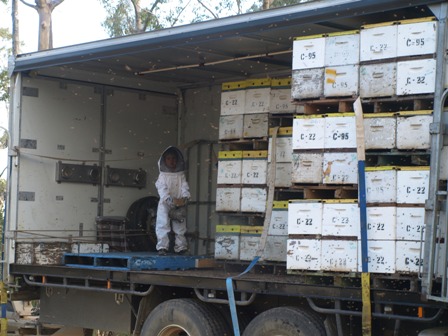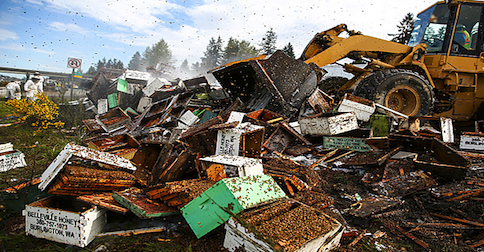It looks like you're using an Ad Blocker.
Please white-list or disable AboveTopSecret.com in your ad-blocking tool.
Thank you.
Some features of ATS will be disabled while you continue to use an ad-blocker.
15
share:
We haven't heard much about the poor honeybees lately.
I still saw bees in my yard last summer....honeybees, bumble bees, other bees.
Although a really cool bee that kinda hovered around flowers has been missing in recent years.
Now we have information coming out that part of the problem is man-made....who would have thought @-@.
www.hngn.com...
And while this Deformed Wing Virus is not necessarily a major threat to bees, when combined with the Varroa virus....bees are in trouble.
www.dbtechno.com...
While huge farms seem the way the world is being fed, the way we pollinate bees with traveling hives may not be a long-term way to pollinate our food.
Sustainable, local farms with local bees needs to be encouraged.
INFO
WIKI: List of diseases of the honey bee
aem.asm.org...
www.newsoxy.com...
RELATED
Plant virus jumps to honey bees, possible link to collapse
I still saw bees in my yard last summer....honeybees, bumble bees, other bees.
Although a really cool bee that kinda hovered around flowers has been missing in recent years.
Now we have information coming out that part of the problem is man-made....who would have thought @-@.
Researchers from the University of California, Berkeley and University of Exeter have discovered that the European honeybee Apis mellifera is the source of the devastating Deformed Wing Virus (DWV) bee disease and that the spread is caused by humans, particularly due to the transport and sales of bees for crop pollination, according to Tech Times.
"People didn't on purpose do this. People don't go to the trouble of sending bee queens to the States for stupid reasons. They do it to get better hives or honey, to get more pollination. Until recently we didn't understand how common it is to spread diseases that way," said Lena Wilfren, a lecturer at the University of Exeter and the lead author of the study, according to The Washington Post.
www.hngn.com...
And while this Deformed Wing Virus is not necessarily a major threat to bees, when combined with the Varroa virus....bees are in trouble.
As reported By Science Daily, although separately they are not major threats to bee populations, when the Varroa mite carries the disease, the combination is deadly, and has wiped out millions of honeybees over recent decades.
Varroa feed on bee larvae while the Deformed Wing Virus kills off bees, a devastating double blow to colonies. The situation is adding to fears over the future of global bee populations, with major implications for biodiversity, agricultural biosecurity, global economies, and human health.
www.dbtechno.com...
While huge farms seem the way the world is being fed, the way we pollinate bees with traveling hives may not be a long-term way to pollinate our food.
Sustainable, local farms with local bees needs to be encouraged.
INFO
WIKI: List of diseases of the honey bee
aem.asm.org...
www.newsoxy.com...
RELATED
Plant virus jumps to honey bees, possible link to collapse
A virus that typically infects plants was found in honey bees and could help explain their decline, researchers in the U.S. and China wrote in a study in the American Society of Microbiology’s online journal mBio.
a reply to: DontTreadOnMe
neonicotinoids are also the pesticides that they believe are causing CCD (colony collapse disorder, where the bees abandon their hive and typically all end up dead)
it's amazing to me that companies will ship tons of colonies via trucks, on the freeways, driving them from as far as Maine all the way down to Florida. That also can't be good for them, getting exposed to a cocktail of different pesticides and chemicals from all of those different places.
yikes, it gets messy fast. It seems to me that the experts are having a tough time now figuring out if it's the virus or the pesticides are are the root problem - both issues seem to have some overlap and cause other complications and both need addressing but no one really has a solid solution
neonicotinoids are also the pesticides that they believe are causing CCD (colony collapse disorder, where the bees abandon their hive and typically all end up dead)
it's amazing to me that companies will ship tons of colonies via trucks, on the freeways, driving them from as far as Maine all the way down to Florida. That also can't be good for them, getting exposed to a cocktail of different pesticides and chemicals from all of those different places.
yikes, it gets messy fast. It seems to me that the experts are having a tough time now figuring out if it's the virus or the pesticides are are the root problem - both issues seem to have some overlap and cause other complications and both need addressing but no one really has a solid solution
a reply to: FamCore
I know, right?
Not to mention road pollution, exhaust and NOISE!!!
Yeah, how healthy could that possibly bee for the bees.
It's a multi-million dollar industry, related to agro-business practices....and just as crazy as growing basically one variety of bananas, and most of the world supply of almonds in one state.
I know, right?
Not to mention road pollution, exhaust and NOISE!!!
Yeah, how healthy could that possibly bee for the bees.
It's a multi-million dollar industry, related to agro-business practices....and just as crazy as growing basically one variety of bananas, and most of the world supply of almonds in one state.
a reply to: DontTreadOnMe
Exactly. I have similar thoughts when I see horses being transported on in the metal trailers - I see a lot of that living in Vermont/New Hampshire..
The trucks:


 (this one has a little boy in the beekeeper suit, i thought that was funny)
(this one has a little boy in the beekeeper suit, i thought that was funny)
and there was that story about a truck crashing that had 14 million bees on it (from 450 hives!) - this was in Seattle last year. I'm sure many other cases are out there too:


www.seattletimes.com...
Exactly. I have similar thoughts when I see horses being transported on in the metal trailers - I see a lot of that living in Vermont/New Hampshire..
The trucks:



and there was that story about a truck crashing that had 14 million bees on it (from 450 hives!) - this was in Seattle last year. I'm sure many other cases are out there too:


www.seattletimes.com...
edit on
8-2-2016 by FamCore because: (no reason given)
Mycillium is the answer.......it has extreme ant viral properties....it can detoxify all kinds of wastes even nuclear.....
Paul Stametz has pioneered research in this area....miracles can happen....
Paul Stametz has pioneered research in this area....miracles can happen....
A few questions come to mind about this problem:
What would be an alternative to the travelling honeybee show?
Wouldn't it require that new colonies be created in all of those places where the commercial pollinators are now providing that service?
And could the new localized colonies actually pollinate the vast quantity of the crops grown by US Agribusinesses? It seems to me that one reason to use massive colonies of honeybees is because they are able to pollinate a large crop all at one time.
Finally, the European honeybee appears to be the one most affected by this plethora of illnesses. Are Africanized honeybees susceptible to these problems?
-dex
What would be an alternative to the travelling honeybee show?
Wouldn't it require that new colonies be created in all of those places where the commercial pollinators are now providing that service?
And could the new localized colonies actually pollinate the vast quantity of the crops grown by US Agribusinesses? It seems to me that one reason to use massive colonies of honeybees is because they are able to pollinate a large crop all at one time.
Finally, the European honeybee appears to be the one most affected by this plethora of illnesses. Are Africanized honeybees susceptible to these problems?
-dex
Pretty worrisome stuff. Bees' niche in the ecosystem is crucial.
I wonder something though......... some parts of the world -- like where I live -- have no bees, but utilize other pollinators (certainly not to the extent that bees do, not even close).
According to this source -- Ecowatch -- President Obama's plan to improve pollinator health falls well short of making a significant difference. Being a global problem, could this possibly be an issue that at least temporarily causes nations to work together?
It's good to have dreams.
I wonder something though......... some parts of the world -- like where I live -- have no bees, but utilize other pollinators (certainly not to the extent that bees do, not even close).
According to this source -- Ecowatch -- President Obama's plan to improve pollinator health falls well short of making a significant difference. Being a global problem, could this possibly be an issue that at least temporarily causes nations to work together?
It's good to have dreams.
new topics
-
Paramilitary Leaks - John Williams
Whistle Blowers and Leaked Documents: 14 minutes ago -
Some sausage, some chicken, some sauce, some onions and some garlic...and some peppers!
Food and Cooking: 1 hours ago -
Hearing more ambulances lately
Medical Issues & Conspiracies: 2 hours ago -
Los Angeles brush fires latest: 2 blazes threaten structures, prompt evacuations
Mainstream News: 2 hours ago -
House Passes Laken Riley Act
Mainstream News: 2 hours ago -
The more I think about it
General Chit Chat: 3 hours ago -
What Comes After January 20th
Mainstream News: 5 hours ago -
Canada as a state .. how would it work?
General Chit Chat: 5 hours ago -
Those stupid GRAVITE commercials
Rant: 5 hours ago -
Let's Buy Greenland
General Chit Chat: 6 hours ago
top topics
-
What Comes After January 20th
Mainstream News: 5 hours ago, 16 flags -
House Passes Laken Riley Act
Mainstream News: 2 hours ago, 16 flags -
Claim: General Mark Milley Approved Heat and Sound Directed Energy Weapons During 2020 Riots
Whistle Blowers and Leaked Documents: 11 hours ago, 12 flags -
Planned Civil War In Britain May Be Triggered Soon
Social Issues and Civil Unrest: 9 hours ago, 6 flags -
Let's Buy Greenland
General Chit Chat: 6 hours ago, 5 flags -
Those stupid GRAVITE commercials
Rant: 5 hours ago, 5 flags -
Hearing more ambulances lately
Medical Issues & Conspiracies: 2 hours ago, 4 flags -
Some sausage, some chicken, some sauce, some onions and some garlic...and some peppers!
Food and Cooking: 1 hours ago, 3 flags -
Los Angeles brush fires latest: 2 blazes threaten structures, prompt evacuations
Mainstream News: 2 hours ago, 3 flags -
The more I think about it
General Chit Chat: 3 hours ago, 3 flags
active topics
-
Winter Storm
Fragile Earth • 43 • : WatchingWatchers -
The more I think about it
General Chit Chat • 4 • : nugget1 -
-@TH3WH17ERABB17- -Q- ---TIME TO SHOW THE WORLD--- -Part- --44--
Dissecting Disinformation • 3961 • : 777Vader -
Why Portals Are Appearing in National Parks
Paranormal Studies • 46 • : WatchingWatchers -
GOD may be ANGRY at CALIFORNIA for Becoming an ABORTION Mecca.
Conspiracies in Religions • 199 • : WatchingWatchers -
House Passes Laken Riley Act
Mainstream News • 9 • : nugget1 -
Claim: General Mark Milley Approved Heat and Sound Directed Energy Weapons During 2020 Riots
Whistle Blowers and Leaked Documents • 23 • : WeMustCare -
This is why ALL illegals who live in the US must go
Social Issues and Civil Unrest • 37 • : WatchingWatchers -
Paramilitary Leaks - John Williams
Whistle Blowers and Leaked Documents • 0 • : FullHeathen -
Get Ready - Here comes the Bird Flu Pandemic - Millions are Notified
Diseases and Pandemics • 69 • : 38181
15
